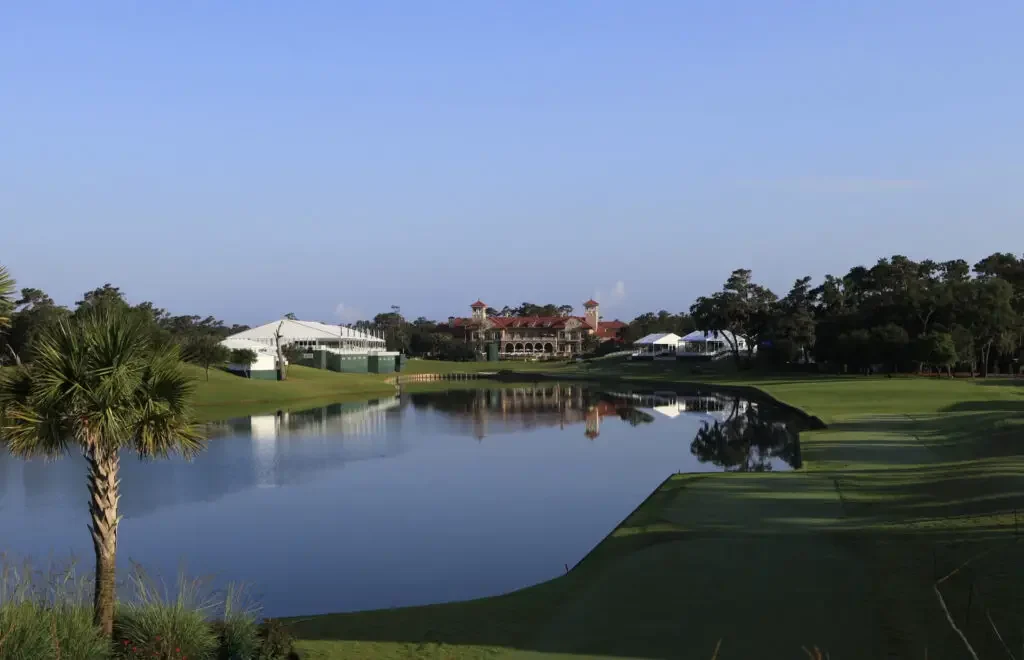A double cross in golf is when you hit the golf ball in the opposite direction you intended to.
This most commonly happens when attempting to hit the opposite of your natural ball flight.
If you naturally hit a fade, your chances of hitting a double cross are much higher when attempting to hit a draw. And vice versa if you naturally hit a draw.
A double cross can be one of the most disastrous shots in the game of golf.
Take a look at the picture below of the 18th hole at TPC Sawgrass and I’ll explain why:

In this case, with water on the left, the safe play is to aim right and play a fade.
You will see this every year at The Players, particularly on Sunday. Players will aim right and purposely hit a fade into the trees/pinestraw on the right to avoid the water.
That said, some players may choose to aim at the left edge of the fairway, or even directly at the water, and play a fade back to the fairway.
If a player chooses to attempt this, but then instead hits a draw/hook into the water, that would be considered a double cross.
For many pros, a double cross is more likely to occur when they are aiming left and trying to hit a fade.
For amateurs, the opposite is true. Since the vast majority of amateurs tend to fade or slice the ball, a double cross will most often occur when an amateur aims right and tries to hit a draw.
A double cross can be particularly disastrous because you will very likely have set up to aim in the direction you don’t want to hit it.
This shot is risky and potentially brutal for scoring as it is usually attempted to avoid a hazard (like in the TPC Sawgrass example above).
Related: What Is A Fade In Golf?
Causes of a Double Cross
A double cross most commonly occurs on a tee shot when hitting a driver.
The driver is the most difficult club to hit consistently and misses are greatly amplified with the driver.
Obviously, something in your golf swing was incorrect but regardless of playing ability, the true cause is almost always a mental error.
You either tried a shot that you don’t have the skill to perform, or you didn’t fully commit to the shot.
Mid to high handicap players
- Likely hit a double cross because they attempted a shot that they have no business trying.
Low handicappers
- They likely haven’t practiced the shot enough and/or they didn’t fully commit to it.
Professional golfers
- They likely simply didn’t fully commit to the shot.
Related: What Is a Mid-Handicapper in Golf?
Why The Ball Went in the Opposite Direction You Intended
Quick primer on the ball flight rules:
- The face angle generally dictates where the golf ball starts.
- If the face is closed to the path, the ball will start left.
- If the face is open to the path, the ball with start right.
- The swing path generally dictates the curvature of the shot.
- If your swing path is inside to out, the ball will curve left (draw/hook).
- If your swing path outside to in, the ball will curve right (fade/slice).
Where you really run into trouble, and where a double cross will be truly disastrous, is when the club face and swing path have the same effect on the ball.
For example, if you aim down the left side of the fairway hoping to hit a fade but instead you swing inside to outside and the clubface is closed at impact, that ball will snap hook off the planet.
If your shot goes left, you likely overcompensated and released the wrists early (closed the clubface). Since you were already aimed left, the ball will move left, directly into whatever trouble you were trying to avoid.
Conversely, if the shot goes right when you wanted it to move left, you likely held off the wrists from releasing, causing the clubface to be open to the club path at impact.
Combine that with an outside to inside swing path and you just might hit the fairway! …. Of a different hole.
Related: What Is A Draw In Golf
How To Avoid The Dreaded Double Cross
Play Smarter
- To avoid hitting bad shots, only attempt shots you are comfortable hitting.
- Always play your preferred shot shape when possible.
- At minimum, never aim directly at a hazard. Never risk being penalized for hitting a straight shot.
Clear your mind
- Trust your swing and have a clear picture of the shot you want to hit.
- If you find yourself thinking about what you don’t want to do, take a step back and reset until you can picture the shot you do want to hit.
Related: What Is A Flyer in Golf?

